Pakistani clothing
Pakistani clothing refers to the ethnic clothing that is typically worn by people in the country of Pakistan and by Pakistanis. Pakistani clothes express the culture of Pakistan, the demographics of Pakistan, and cultures from Punjab, Sindh, Balochistan, Khyber Pakhtunkhwa, Gilgit-Baltistan, and Kashmir regions of the country. The clothing in each region and culture of Pakistan reflect weather conditions, way of living, the textiles and embroidery used and its distinctive style which gives it a unique identity among all cultures.
Pakistani national dress
The Shalwar kameez, Achkan Sherwani and Kurta shalwar Kameez are the national dresses of Pakistan[1][2] and is worn by men and women in all five provinces of Punjab, Sindh, Balochistan, Khyber Pakhtunkhwa, and Gilgit-Baltistan in the country and in Azad Kashmir. Shalwar refers to loose trousers and kameez refers to shirts. Since 1982, all officials working in the secretariat are required to wear the national dress.[3]Each province has its own variant of salwar kameez such as Sindhi shalwar kameez, Punjabi shalwar kameez, Pashtun shalwar kameez, and Balochi shalwar kameez. Pakistanis wear clothes ranging from exquisite colours and designs to various types of fabric such as silk, chiffon, cotton, etc.[4][5]
 Traditional Khet partug. (Traditional loose shalwar worn in Khyber Pakhtunkhwa) (1842)
Traditional Khet partug. (Traditional loose shalwar worn in Khyber Pakhtunkhwa) (1842)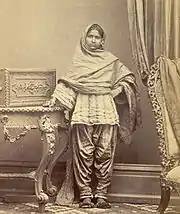
 Balochi traditional dress
Balochi traditional dress Balochi male shalwar kameez.Quetta.1867
Balochi male shalwar kameez.Quetta.1867 Pakistani dress
Pakistani dress
Men's clothing
Men wear shalwar kameez, kurta, Pakistani Waistcoat, achkan and sherwani, churidar, or pajama. Other items of clothing include the jama and the angarkha. Headgear includes turbans, the Jinnah Cap, also called Karakul, Fez, also called Rumi Topi, and Taqiyah (cap). Peshawari chappal and Khussa are popular foot wear. Other items include traditional shawls made of Pashmina or other warm materials especially in the Northern regions of the country, mainly, Khyber Pakhtunkhwans usually wear the Pakol hat,
Every province has a different and unique cultural dress.
Balochistan
In Balochistan, traditionally a long jama (robe) like a smock-frock is worn down to the heels, loose shalwar, a long chadar or scarf, a pagri of cotton cloth, and mostly shoes that narrow at the toe.[6] The material is thick cloth with a very wide shalwar to protect against the hot winds of the dry Sulaiman Range and Kharan Desert.
 Elders of Kirani Quetta in turbans and hats
Elders of Kirani Quetta in turbans and hats Pakistani Baloch
Pakistani Baloch Traditional Balochi suits
Traditional Balochi suits
Sindh
[7][8] with a kameez called cholo.[9] Other traditional clothing includes the Sindhi cap and Ajrak of beautiful designs which are made locally. Men also traditionally wear the dhoti and the long angerkho.
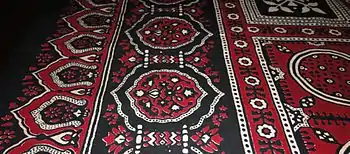 Sindhi Ajrak
Sindhi Ajrak.jpg.webp) Sindhi cap
Sindhi cap.jpg.webp) Man in Sindhi long angerkho(1845)
Man in Sindhi long angerkho(1845)
Punjab
Punjabi men wear the straight cut Punjabi shalwar kameez, kurta, or shalwar. Dhoti, lungi, or tehmat are often worn in rural areas.[10][11][12] Other Punjabi shalwar styles include the Pothohari shalwar,[13] Multani shalwar, Dhoti shalwar, and the Bahawalpuri shalwar which is very wide and baggy[14] with many folds. Turban of a thin cloth is also worn especially in rural areas of Punjab where it is called pagri. Footwear include the khussa and Peshawari chappal, which is also widely worn.
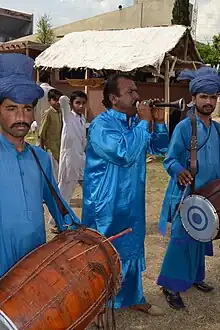 Punjabi kurta and tehmat
Punjabi kurta and tehmat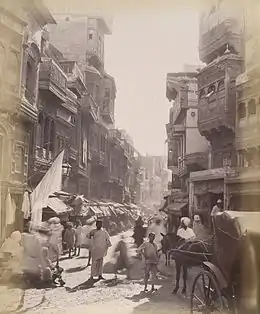 Punjabi clothing of Lahore, 1890s
Punjabi clothing of Lahore, 1890s Saraiki Turban
Saraiki Turban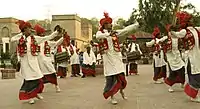 Bhangra Dance performers in Punjab wearing Kurta and Tehmat.
Bhangra Dance performers in Punjab wearing Kurta and Tehmat. Saraiki Kurta
Saraiki Kurta Prince Suba Sadiq Abbasi, Bahawalpur in Bahawalpuri shalwar
Prince Suba Sadiq Abbasi, Bahawalpur in Bahawalpuri shalwar Men in Attock in shalwar kameez
Men in Attock in shalwar kameez
Khyber Pakhtunkhwa
Pashtun dress differ according to region but usually people wear traditional Peshawari chappal[15] as footwear and a Pakol or turban as headwear. The traditional male Pashtun dress includes the Khet partug,[16] Peshawari shalwar, and the Patke tunban. Males usually wear kufi, Peshawari cap, turban, or Pakol as traditional headgear.
 Clothing worn by most Pashtun males in Afghanistan and Pakistan
Clothing worn by most Pashtun males in Afghanistan and Pakistan Amir Chand Bombwal, Peshwar editor wearing a Peshawari Turban
Amir Chand Bombwal, Peshwar editor wearing a Peshawari Turban Man wearing pakol
Man wearing pakol
Gilgit-Baltistan
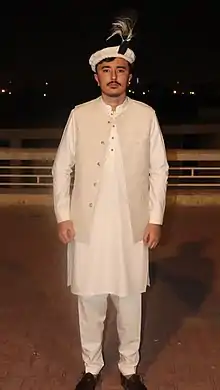 A Gilgiti man wearing the cultural "Khoi" cap of Gilgit-Baltistan
A Gilgiti man wearing the cultural "Khoi" cap of Gilgit-Baltistan
Azad Kashmir
The clothing of Azad Kashmir includes various styles of the shalwar kameez. It is called Pheran.
Women's clothing
Shalwar kameez
Pakistani women wear the shalwar kameez which is worn in different styles, colours, and designs which can be decorated with different styles and designs of embroidery. The kameez can be of varying sleeve length, shirt length, and necklines. The drawers can be the straight-cut shalwar, patiala salwar, churidar, cigarette pajama, tulip trouser, samosa pajama, or simple trouser
Dupatta
The Dupatta is treated just as an accessory in current urban fashion. Most women who carry it nowadays wear it just as a decorative accessory; it's usually worn wrapped around the neck or hanging down the shoulder. [Dupatta] is also used by some women when entering a mosque, dargah, where they cover their head with a dupatta while entering such places. It is widely worn by women in weddings and other parties out of choice and fashion. On such occasions, mostly it is wrapped around the waist, neck, or just draped on a shoulder. It is used with different embroidery designs of Kamdani and Gota.
Burqa
In Pakistan, upper and middle-class women in towns wear burqas over their normal clothes in public.[17][18] The burqa is the most visible dress in Pakistan. It is typically a tent-like garment worn over the ordinary clothes and is made of white cotton. Many upper-class women wear a two-piece burqa which is usually black in colour but sometimes navy blue or dark red. It consists of a long cloak and a separate headpiece with a drop-down face veil. Some educated urban women no longer wear the burqa. The burqa is also not worn by rural peasant women who work in the fields.[19] In rural areas only elite women wear burqas.[17][18] Purdah is still common in the rural elite and urban middle class, but not among rural farmers.[20]
Bridal dresses
Some Pakistani brides may choose to wear dresses known as Nikah or walima dress. The outfit is called gharara and mimics the traditional dress of India - it includes a skirt known as a lehenga/gharara and dupatta. However, instead of cholis worn by Indian women, Pakistani brides wear a long shalwar top.
Other traditional dresses
On special occasions such as Eid more heavily embroidered iterations of the shalwar kameez are worn by Pakistani women.
Farshi Pajama is an old traditional dress which is worn occasionally. Laacha is worn in Punjab,[21] the lower part of which resembles the dhoti.
Balochistan
The typical dress of a Baloch woman consists of a long frock and shalwar with a headscarf.[22] Balochi women wear heavy embroidered shalwar kameez and dupatta with the embroidery utilising Shisha work.[23] The Balochi Duch from Makran District is one of the many forms of Balochi dresses and is famous all across Balochistan. Since it is purely hand embroidered, Balochi Duch is expensive and it takes months to complete a single Balochi suit.
 Pakistani Baloch Lady
Pakistani Baloch Lady Traditional Balochi dresses
Traditional Balochi dresses Children in Quetta wearing local embroidery designs
Children in Quetta wearing local embroidery designs Malookan, Pakistani Baloch embroidery artist
Malookan, Pakistani Baloch embroidery artist
Sindh
In addition to wearing the suthan and cholo, Sindhi women wear the lehenga and choli known as the gaji which is a pullover shirt worn in the mountain areas of Sindh. The gaji is composed of small, square panels, embroidered on silk and sequins. The neck line of the gaji is cut high, and round on one side, with a slit opening extending the other. Unmarried girls wear the opening to the back and married women, to the front.[24] Sindhi clothing displays embroidery using mirrors.[23]
.jpg.webp) Portrait of a girl from Sindh, (1870s)
Portrait of a girl from Sindh, (1870s)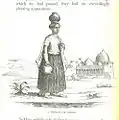 Sindhi lehenga, choli, and Sindhi traditional pantaloon shalwar
Sindhi lehenga, choli, and Sindhi traditional pantaloon shalwar Sindhi girl
Sindhi girl Ralli material of Sindh
Ralli material of Sindh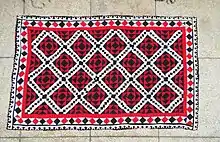 Ralli
Ralli
Punjab
Punjabi women wear the straight cut Punjabi shalwar kameez,[25] which is most frequently worn. Punjabi women, in villages, also wear the Pothohari shalwar, the Patiala shalwar, the laacha (tehmat),[26] kurti,[27] ghagra,[28] lehenga, and phulkari.
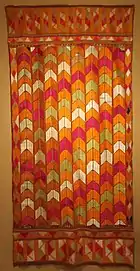 Phulkari
Phulkari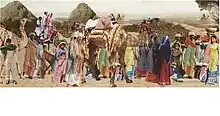 Saraiki Tradition women wearing ghagra
Saraiki Tradition women wearing ghagra Cultural dress
Cultural dress Bahawalpur kameez
Bahawalpur kameez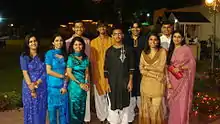 Pakistani Punjabis at a wedding
Pakistani Punjabis at a wedding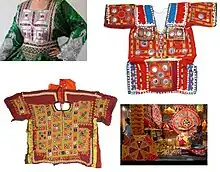 Saraiki fashion
Saraiki fashion Rohi woman's dress
Rohi woman's dress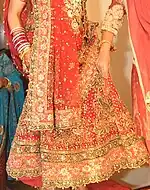 Lehenga with Gota Embroidery
Lehenga with Gota Embroidery Josephine Powell Collection, voor 1965. Phulkari kurta
Josephine Powell Collection, voor 1965. Phulkari kurta
Khyber Pakhtunkhwa
In urban areas women typically wear the shalwar kameez.[29] Pashtun women commonly wear shalwar kameez and in some regions, particularly in Tribal areas, women wear firaq partug which is also worn in neighbouring Afghanistan. In Kalash region, women wear embroidered long shirts.
 Kalash women traditional clothing
Kalash women traditional clothing Kalash valley
Kalash valley Kalash girl
Kalash girl%252C_Indus_Kohistan%252C_Northwest_Frontier_Province%252C_Pakistan%252C_view_1%252C_mid_20th_century%252C_cotton%252C_metal_and_glass_beads%252C_plastic_buttons_-_Textile_Museum_of_Canada_-_DSC00930.JPG.webp) Wedding dress (jumlo), Indus Kohistan, Northwest Frontier Province, Pakistan, view 1, mid 20th century, cotton, metal and glass beads, plastic buttons - Textile Museum of Canada - DSC00930
Wedding dress (jumlo), Indus Kohistan, Northwest Frontier Province, Pakistan, view 1, mid 20th century, cotton, metal and glass beads, plastic buttons - Textile Museum of Canada - DSC00930 Child of Khyber Pakhtunkhwa. 1920 approx.
Child of Khyber Pakhtunkhwa. 1920 approx.
Wedding dresses
In Pakistan, the traditional wedding ceremony is celebrated by wearing different clothes in each wedding event. Usually, the style and designs of wedding attire vary across different regions from north to the south among different ethnic communities. However, in major urban cities such as Karachi, Lahore, Faisalabad, and Rawalpindi, on the occasion of the Rasm-e-Heena (Mendhi), men wear an embroidered Kameez in glittering colours with simple shalwar. Up to the wedding day, the bride may wear a yellow[30] or orange kameez, with a simple shalwar, Patiala shalwar,[31] yellow dupatta, and yellow paranda — more commonly in the Punjab region of Pakistan. However, in other regions customs vary. For example, in the north-west, particularly in the tribal areas, it is customary for a bride to wear Firaq Partug.
During baraat and walima functions, the groom usually wears kurta shalwar or kurta churidar with special sherwani and khussa. However, in some regions, including Balochistan, among Baloch and Pashtuns (in the north of the province), and Khyber Pakhtunkhwa province, mostly among Pashtuns and Kohistanis, grooms customarily wear simple, more often white, colour shalwar Kameez and a traditional Baloch Bugti Chappal (in Baloch dominated regions) or Peshawari Chappal in Khyber Pakhtunkhwa and a traditional headwear such as the Pashtun style Patke or a Baloch style turban. In Punjab and Karachi, during the event of baraat, grooms may wear traditional sehra on their heads, and brides may normally wear a shalwar kameez.[32]
 Wedding in Punjab
Wedding in Punjab Embroidered dress, view 2, Kohistan, Northwest Frontier Province, Pakistan, early 20th century, cotton, silk, glass, plastic, silver, brass - Fernbank Museum of Natural History - DSC00131
Embroidered dress, view 2, Kohistan, Northwest Frontier Province, Pakistan, early 20th century, cotton, silk, glass, plastic, silver, brass - Fernbank Museum of Natural History - DSC00131 Little Pakistani girl in traditional formal ghagra dress
Little Pakistani girl in traditional formal ghagra dress Pakistani Bazaar
Pakistani Bazaar A bride in Punjab
A bride in Punjab
Pakistani clothing companies and brands
The following is a list of notable Pakistani clothing companies and brands.
Pakistani fashion
Pakistani fashion has flourished well in the changing environment of the fashion world. Since Pakistan came into being, its fashion has been historically evolved from different phases and made its unique identity. At this time, Pakistani fashion is a combination of traditional and modern styles and it has become the cultural identification of Pakistan. Despite all modern trends, the regional and traditional dresses have developed their own significance as a symbol of native tradition. This regional fashion is not static but evolving.
Pakistan Fashion Design Council, based in Lahore, organizes Fashion Week and Fashion Pakistan, based in Karachi, organizes fashion shows in that city. Credit goes to Ayesha Tammy Haq, a British-trained lawyer and chief executive of Fashion Pakistan, who came up with the idea for Pakistan’s first fashion week, held in November 2009.[33]
Pakistani fashion industry
.jpg.webp)
Pakistani fashion industry is introducing Pakistani traditional dresses all over the world as cultural representatives and is becoming a reason to introduce international trends in Pakistan. Pakistani media, Film Industry, and Internet have the biggest roles in promoting fashion in Pakistan. There are a lot of TV Channels, Magazines, Portals,[34] and websites which are working only for the fashion industry.
Pakistani fashion designers
Pakistani fashion Brands
Pakistani fashion models
The following is a list of Pakistani models.
Male models
Female models
- Meesha Shafi
- Maya Ali
- Amina Haq
- Ayesha Omar
- Ayyan Ali
- Iman Ali
- Sabeeka Imam
- Juggan Kazim
- Iffat Rahim
- Mariyah Moten
- Mehreen Raheel
- Nargis Fakhri
- Noor
- Reema Khan
- Rabia Butt
- Rubya Chaudhry
- Saba Qamar
- Sadia Imam
- Sana (Lollywood)
- Sunita Marshall
- Tooba Siddiqui
- Vaneeza Ahmad
- Veena Malik
- Yasmeen Ghauri
- Zara Sheikh
- Zainab Qayyum
Pakistani fashion stylists
Pakistani stylists also have a major contribution in giving the celebrities a new look. Their work is also appreciated within and outside of Pakistan. Here is a list of Pakistani Fashion stylists[35]
Pakistani fashion events
Extensive fashion activities are shown in Pakistani Fashion Events held in different parts of the country as well as abroad in which versatile approaches towards new trends always amuse the spectators.
- Lahore Fashion Week
- Karachi Fashion Week
- Peshawar Fashion Week
- Miss Pakistan World
Pakistani fashion awards
Pakistani fashion schools
Here is a list of Pakistani fashion institutes.
Pakistani fashion media
Here is a list of Pakistani fashion media.
References
- Nobleman, Marc Tyler (2003) Pakistan
- West, Barbara. A (2009) Encyclopedia of the Peoples of Asia and Oceania
- Ali Banuazizi, Myron Weiner (1986) The State, Religion, and Ethnic Politics: Afghanistan, Iran, and Pakistan; [this Vol. Had Its Origin in a Conference on "Islam, Ethnicity and the State in Afghanistan, Iran and Pakistan" ... Held in November 1982, in Tuxedo, New York]
- Koerner, Stephanie; Russell, Ian (16 August 2010). Unquiet Pasts: Risk Society, Lived Cultural Heritage, Re-Designing Reflexivity - Stephanie Koerner, Ian Russell - Google Books. ISBN 9780754675488. Retrieved 14 June 2012.
- Qadeer. Mohammad (2006) Pakistan - Social and Cultural Transformations in a Muslim Nation
- Mir Khuda Bakhsh Marri (1974) Searchlights on Baloches and Balochistan
- Hasan, Shaikh Khurshid (1996) Chaukhandi tombs in Pakistan
- Gera, Nalini (2003) Ram Jethmalani: the authorized biography
- Illustrated Weekly of Pakistan, Volume 20, Issues 27-39 (1968)
- Pakistan culture (1997)
- West Pakistan Year Book (1961)
- Area Handbook for Pakistan (1975)
- Mohinder Singh Randhawa. (1960) Punjab: Itihas, Kala, Sahit, te Sabiachar aad.Bhasha Vibhag, Punjab, Patiala
- Current Opinion, Volume 25 (1899)
- Shah, Danial (22 April 2009). "Peshawari Chappal | Flickr - Photo Sharing!". Flickr. Retrieved 14 June 2012.
- Pathans: Compiled Under the Order of the Government of India at the Recruiting Office, Peshawar (1938)
- Latif, Abdul (1977). Population Census of Pakistan, 1972: Gujranwala. Manager of Publications. p. 9.
- Latif, Abdul (1978). Population Census of Pakistan, 1972: Lahore. Manager of Publications. p. 9.
- Nyrop, Richard (1975). Area Handbook for Pakistan. U.S. Government Printing Office. p. 109.
- "Archived copy". Archived from the original on 19 October 2022. Retrieved 19 November 2022.
{{cite web}}: CS1 maint: archived copy as title (link) - Focus on Pakistan, Volume 2 (1972)
- Dashti, Naseer (2012) The Baloch and Balochistan: A Historical Account from the Beginning to the Fall of the Baloch State
- Illustrated Weekly of Pakistan, Volume 21, Issues 1-16
- Peter J. Claus, Sarah Diamond, Margaret Ann Mills (2003) South Asian Folklore: An Encyclopedia : Afghanistan, Bangladesh, India, Nepal, Pakistan, Sri Lanka
- Tracey Skelton, Gill Valentine (2005) Cool Places: Geographies of Youth Cultures
- Nasreen Askari, Rosemary Crill (1997) Colours of the Indus: Costume and Textiles of Pakistan In the cities, straight-cut shalwars and pants are worn by majority. The females youngsters in the Punjab frequently wear jeans and short shirts or tee-shirts. id=jWRQAAAAMAAJ&q=lacha+punjabi+dress&dq=lacha+punjabi+dress&hl=en&sa=X&ved=0CFIQ6AEwB2oVChMI0LODq7KkxwIV7wrbCh16ogS8
- Punjab District Gazetteers: Rawalpindi District (v. 28A) (1909)
- Chaudhry, Nazir Ahmad (2002) Multan Glimpses: With an Account of Siege and Surrender
- Peter J. Claus, Sarah Diamond, Margaret Ann Mills (2003) South Asian Folklore: An Encyclopedia : Afghanistan, Bangladesh, India, Nepal, Pakistan, Sri Lanka
- Illustrated Weekly of Pakistan, Volume 20, Issues 27-39 (1968)
- "Archived copy". Archived from the original on 15 October 2014. Retrieved 4 October 2011.
{{cite web}}: CS1 maint: archived copy as title (link) - Malik, Iftikhar Haider (2006) Culture and Customs of Pakistan
- In Pakistan, fashion weeks thrive beyond the style capitals of the world
- "What is a Portal?". Itservices.hku.hk. Retrieved 14 June 2012.
- "List of top Pakistani Fashion Stylists at Fashion Central". Fashioncentral.pk. Retrieved 14 June 2012.